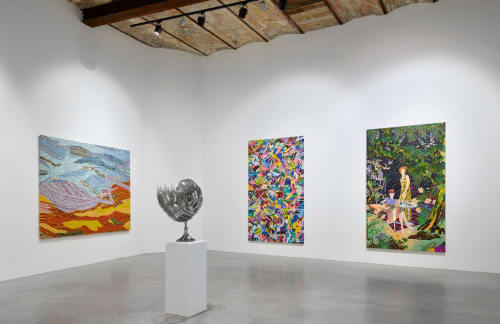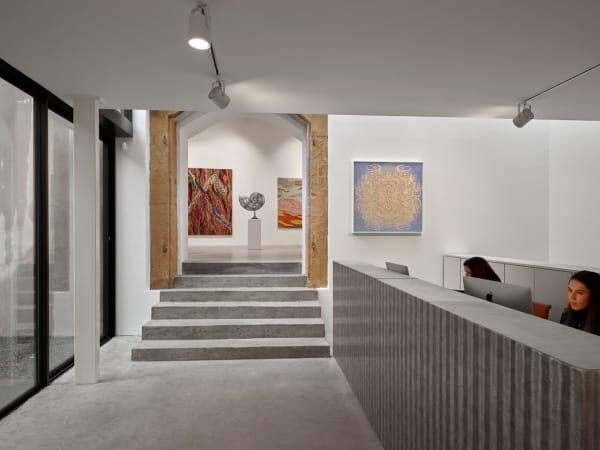Pardon My Language, Curated by Tomokazu Matsuyama: Zidoun-Bossuyt | Luxembourg, Germany
Pardon my Language’ is an exploration of how Globalization has changed our perception of cultural identity and how ‘identity’ is shifting and changing in the 20th/21st Century. The exhibition, curated by Tomokazu Matsuyama, aims to examine the blurred social and cultural boundaries which make our time and place unique. A printed catalogue will be published including a curatorial essay by Peter Doroshenko, Executive Director of Dallas Contemporary.
Language is a skin: I rub my language against the other. It is as if I had words instead of fingers, or fingers at the tip of my words. My language trembles with desire.
- Roland Barthes
The very definition of the real becomes: that of which it is possible to give an equivalent reproduction. The real is not only what can be reproduced, but that which is always already reproduced. The hyper-real.
- Jean Baudrillard
Looking at the linguistic singularities produced by individual artists one considers the ways in which they relate to connections that tend to establish uniformity in norms of production. The norms for art production find their roots in the ethics of the individual artists who bravely represent the scene of a historical condition that for the moment seems to be irreversible.
Yet, it’s 2018 and the art works in Pardon My Language demonstrate structural characteristics derived from common features of cultural contexts in Europe and North America. Even if art tends towards the production of historically privileged objects, it also finds its sphere of action within a system of interconnecting functions that separately refer to a variety of agents and cultural forces.
The art world includes artists, gallerists, collectors, museum directors, critics and the public at large, and it constitutes the natural habitat in which the products of creativity are born, developed, and circulated (they are all present, and actively involved with this group exhibition). The work’s initial identity as an artwork acquires a cultural plus value resulting from the support of other forces, persons, and functions that come into play in an ever more international art circuit.
From this point of view, every movement and its generation of artists are subjected to microscopic examination, a certain method of scrutiny, which tends to function in terms of objectivity and internationality. These terms are the up-to-date technocratic counterparts of traditionally auric notion of the immortality of art.
The artwork now manifests itself in terms of its objective presence as a formal structure and no longer as a process or event; its duration is both measured in terms of space and in the ability to defend its specificities within the various contexts in which it circulates. In this way, the work’s incorporation into the art system highlights its existence and stimulates a form of social response that confers the status of objective presence to the formal result of a mode of production initially steeped in fantasy, and exclusively connected to the artist’s ability to create a personally significant image. If the art of the past is the art reproduced in art history books, the art of the present is art that is observed, accepted, and reinforced by the art system.
The proverbial value of quality as specifically and necessarily characteristic of artworks now becomes not only the artist’s sphere, but also that of the other agents who exercise a function within this system. A kind of elective affinity, paradoxical and objective, articulates itself throughout the international art circuit along the lines that subject the horizontal stratification of art production to a series of vertical measurements.
These measurements concern the varied levels of cultural policy that correspond to the activities of the various participants in the system. And this inevitably creates an economic and operative solidarity based on common aesthetic taste, which is the support and launching pad for the diffusion of the artwork.
With the mass production of art, which is ever more widely distributed in a society with an industrial system promoting a general access to culture, the lines of vertical tendency take the upper hand and impose a kind of art that is principally and initially legible through movements and common poetics.
These movements and poetics become the protective nurturing places well as the magnifying glass that then reveal the capacity to individuate the presence of the individual artist and the individual artworks.
If image is the ineluctable result that marks the final destination of every form of behavior, it is likewise clear that the total image, since prestige and social reverberation result from the qualitative power of an entire series of individual activities, is what functions as the basis for determining that cultural plus value, which is essential for establishing the existence of the artwork.
By now a kind of post-conceptual art is manifest in Europe and North America, typified by the significant presence of the cultural agents that flank the artist. The predominant symbolic value of money has shattered the idealistic hierarchy that once constituted the terms in which art was to be considered.
If former ideological schemes used to determine the existence of a dichotomy inhabited on the one hand by culture (the artist and critic) and on the other by economics (the market and collectors), this dichotomy has now been destroyed by the high specialization of individual agents within the art system.
The forces represented by these various mediators interpenetrate, encounter, and conflict with one another in a dialectic that is capable of constantly shifting the privileged point of view from which society judges the artwork. By now, the specialization of labour has also become germane to art production; it determines the existence of powerful contexts that are no longer a simple question of economic approval (the market) or the approval in terms of taste (the collectors), which initially functioned as mechanisms of comment and reinforcement.
The critics, the market, the collectors, the museums, and the public are now representative of specialized activities that exert a vigorous influence on art production, determining the directions of research by means of tangible shifts in taste. Mass society, paradoxically enough, accepts art because of the very fact of its existence and no longer poses questions concerning its function and finalities except by way that it extends through into the 21st century, the possibility for a moment of enormous development and social expansion.
This is the homogenized context in which European and North American art find themselves, accepting the articulation of a system that is what it is and representing the arrival of technological advancement and post-conceptual ideas that relate to all activities in terms of their probable absorption, which here implies the consumption of art as a form of social privilege.
The artists in Pardon My Language don’t so much simulate the importance of their work as rather draw attention to the historical impossibility of employing their own language as an instrument for the modification of the prospects of history. What they do is more a question of showing us the prospects inherent within the social consumption of art and revealing the learning mechanisms that it produces, including those mechanisms connected to the possible production of cultural value.
— Curatorial text courtesy of Zidoun-Bossuyt Gallery










